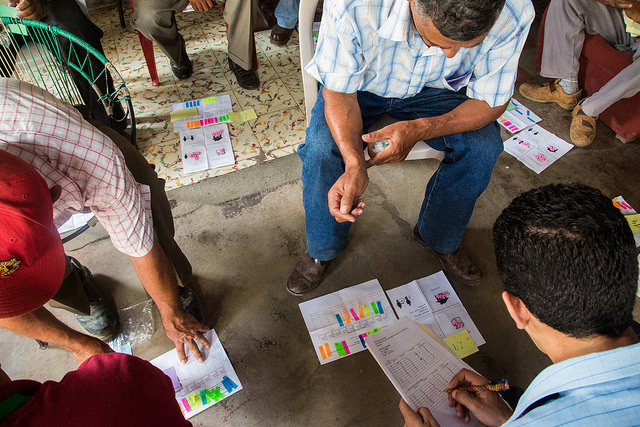VIDEO: What tools do Honduran farmers want for climate risk?
Text by Sofía Martínez
Video by Elisabeth Gawthrop, Sofía Martínez and Courtney St. John
Answers from insurance research
La version en español esta disponible aquí.
During the first of the two growing seasons of 2015, grain farmers in El Paraíso, Honduras faced one of the worst droughts in history, with losses ranging from 60 to 100% of the maize planted.
As part of an engagement with CGIAR’s Research Programme on Climate Change, Agriculture and Food Security, the International Research Institute for Climate and Society and local Honduran partners have been working to identify and implement farmer-driven, development-focused climate risk solutions. Through interactive exercises, grain farmers have worked together with the team of experts since 2014 to design and tailor index insurance in the pilot region of El Paraíso, Honduras.
Scientists from IRI and Zamorano University led interactive, experimental activities in May 2015, with the purpose of understanding farmers’ preferences about insurance. The exercises also serve as a test for the index designed with the farmers in 2014. The index determines whether farmers will receive a payout from the insurance product based on CHIRPS satellite precipitation estimates for two distinct growing seasons: primera (mid-May to mid-June and late-July to mid-August) and postrera (mid-September to mid-October).

Photo: Elisabeth Gawthrop/IRI
In November 2015, as part of the final round of the experimental activities in the region, farmers were given payouts corresponding to how they chose to allocate income between savings and insurance in the May 2015 activities. Whether a farmer receives an insurance payout – and if so, how much he or she receives – is based on the climate conditions of this year’s seasons.
Most of the participating farmers in El Paraíso received insurance payouts for the primera season, but even within this small region drought intensity varied enough for differences in payouts. Of the 10 communities, 3 received a full payout, 4 received moderate payouts and three did not receive any payouts. However, those three also experienced losses in the first season’s production of maize.
Therefore, this event helped stakeholders better understand how drought risks can impact farmers at different times throughout the season. From these activities we were able to refine the index in a way that is capturing most, if not all, of the drought risk that remains after implementing climate risk management tools.
Donate today to help us continue these activities.
- More on how we work with farmers around the world to design insurance, and why it works, in this video.
- How do satellites help rural farmers? Learn more about remote sensing and index insurance.

You must be logged in to post a comment.